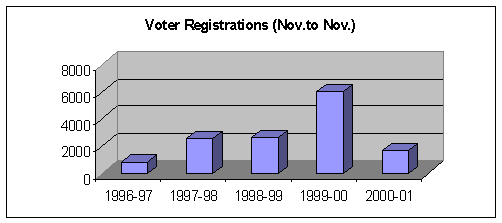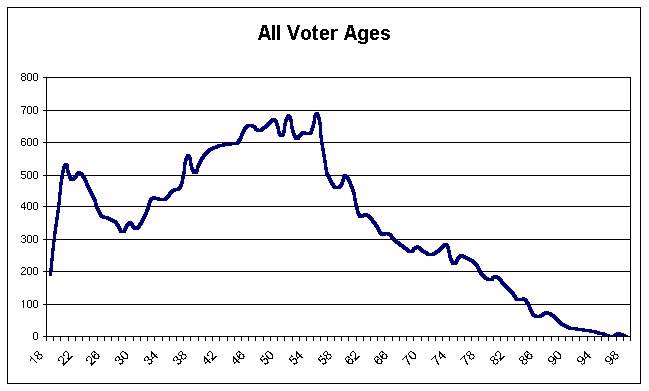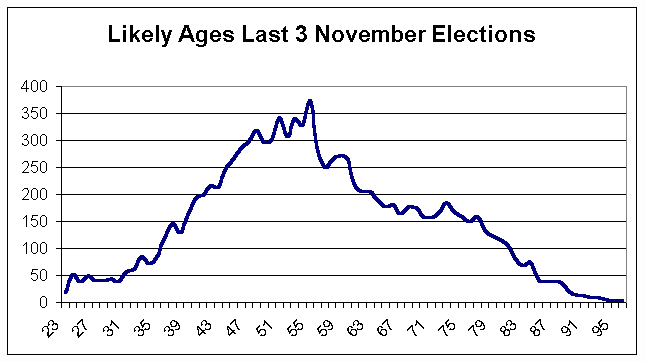Party & Gender Overview
Below you will see a table of the registered voters
where gender of the voter is identified. Of the 29,200 registered voters in
the database, 29,149 have a gender tag. The voters are also categorized with
respect to party affiliation:
D = Democrat | R = Republican | O = Other
| X = Declined to State.
|
Gender |
D |
R |
O |
X |
Voter Total |
|
F |
6145 |
7511 |
531 |
1818 |
16005 |
|
M |
4092 |
6804 |
545 |
1703 |
13144 |
|
Party Total |
10237 |
14315 |
1076 |
3521 |
29149 |
There are more females than males registered to vote.
This gender distribution is more prominent among Democrats than Republicans
while all other voter party affiliations are close to gender parity.
There are more Republicans than Democrats registered to
vote. Some significance relative to conservative and liberal views can be
attributed to party affiliation but should not be assumed.
Assessing
Community Growth
The
registered voter population offers an effective method to get a thumbnail of
growth within the community. The chart shown below will provide some
perspective regarding growth within the city.

The chart
graphically represents the new voters from November to November for the year
spans indicated. The chart demonstrates that there is a persistent trend
toward an increase in registered voters.
Most notable is the increase in the 1999-2000 year; however, since this
was a presidential election year and since there was a concerted voter
registration effort on the part of both major parties, this number must be
adjusted as an indicator of community growth by using the other year’s
numbers as normative (the average is about 2000 new voters each year).
Likely Voters Profile
An analysis of voter history was done to determine those
registered voters who are most likely to vote in this election. Below, you
will see a gender/party table; however, this table only shows the likely
voters.
|
Gender |
D |
R |
O |
X |
Voter Total |
|
F |
2396 |
3506 |
106 |
371 |
6379 |
|
M |
1651 |
3248 |
100 |
373 |
5372 |
|
Party Totals |
4047 |
6754 |
206 |
744 |
11751 |
Of the 29,149 voters with gender tags, only 11,751
(about 40%) demonstrate a persistent pattern of regular participation. It is
significant to note that Republican voters outnumber Democratic voters by
approximately 2,700 voters. Also, the low number of other and unknown party
voters diminishes their ability to impact an election outcome.
Voter Age Profile
Not all voters provided their age. Of the 29,149 voters
with gender tags, only 28,181 provided their age. This is a large enough
number of registered voters to create a meaningful age profile of the voter
population. Below you will see a graph of the city voter
population.

It can be seen from this graph that there are two age
bumps in the voter population. The first age bump appears in the 21 to 27 year
age group. The second age bump ranges from 37 to 62 years. Although
interesting, the age profile takes on significance only when it is
applied to the likely voter population. The likely voter age profile is shown
below.

It can be seen from this likely voter age profile that
the voters under the age of 37 do not represent a significant voter presence.
The age bump from ages 37 to 79 represent the significant voter presence. It
should also be noted that voters over the age of 79 represent an important and
persistent voting block.
Certainly, any message to the voters, whether embodied
in a brochure or a campaign mailer, should be formulated to appeal to the
prominent voter age groups.
Absentee vs. Poll Voting
Whether a voter votes at the polls or by absentee is an
important consideration when determining campaign strategies. Absentee voters
tend to cast their ballots in early-to mid-October and should be outreached
prior to that time. Below you will see a gender/party table of those likely
voters that persistently vote absentee.
|
Gender |
D |
R |
O |
X |
Voter Total |
|
F |
1043 |
1737 |
46 |
152 |
2978 |
|
M |
632 |
1586 |
44 |
126 |
2388 |
|
Party Totals |
1675 |
3323 |
90 |
278 |
5366 |
There are 5,366 likely voters that are likely to vote
absentee in this election. Almost twice as many Republicans as Democrats are
likely to vote absentee. An early outreach to these voters should be
undertaken to capture their support. This outreach could be a brochure
mailing, a specific mail piece addressing their absentee vote, a walking visit
or some combination thereof. Failure to positively influence these voters in
your favor could impact your election success. It is significant to note that
absentee voters represent almost 46% of the 11,751 likely voters.
To further define these absentee voters, the table below
shows the likely absentee voters who are over the age of 55.
|
Gender |
D |
R |
O |
X |
Voter Total |
|
F |
530 |
906 |
20 |
74 |
1530 |
|
M |
344 |
845 |
13 |
57 |
1259 |
|
Party Totals |
874 |
1751 |
33 |
131 |
2789 |
Of the 5,366 likely absentee voters, 2,789 (almost 52%)
are over the age of 55. these absentee voters should have a message crafted to
secure their support in the early October time frame.
Poll Voters
The table shown below represents the likely voters that
persistently vote at the polls.
|
Gender |
D |
R |
O |
X |
Voter Total |
|
F |
1353 |
1769 |
60 |
219 |
3401 |
|
M |
1019 |
1662 |
56 |
247 |
2984 |
|
Party Totals |
2372 |
3431 |
116 |
466 |
6385 |
As with the absentee voters there are more Republicans
than Democrats voting at the polls. This group of voters should be outreached
by literature or by precinct walks in an attempt to secure their support at
the polls. The table below shows likely poll voters that are over the age of
55.
|
Gender |
D |
R |
O |
X |
Voter Total |
|
F |
533 |
650 |
10 |
65 |
1258 |
|
M |
437 |
676 |
20 |
85 |
1218 |
|
Party Totals |
970 |
1326 |
30 |
150 |
2476 |
It is significant to note that these over 55 likely poll
voters are almost 39% of the all likely poll voters. Once again, this age category
represents a significant voter group and a specific outreach directed toward
them is strongly indicated.
Summary
This analysis has presented a profile of voters for a
2002 City Council Election. The counts shown in the tables represent
individual voters. For the purpose of precinct walks or the generation of mail
lists, voters will be aggregated into households. As a general rule of thumb,
when grouping into households individual voter counts will decrease by
approximately 30%.
It is recognized that after review of this database
analysis, additional voter profiles may be needed to support campaign
strategies.
Given the contested nature of this city council
election, an aggressive campaign strategy is recommended that includes:
-
Precinct walks to likely Republican absentees over 55
years of age starting at the close of candidate filing and ending on
October 7th.
-
Two mail pieces to all likely absentee voters to hit
on October 1st and again October 15th.
-
Precinct walks to likely Republican poll voters
starting on October 7th and ending on election day.
-
Two mail pieces to all likely poll voters to hit on
October 25th and on November 4th.
This voter analysis serves as an information baseline to
assist the campaign manager in the development of strategies to reach out to the
voters. We recognize that each voter population will have additional unique
considerations. We will work with your campaign to address these unique needs by
providing additional voter profile development.